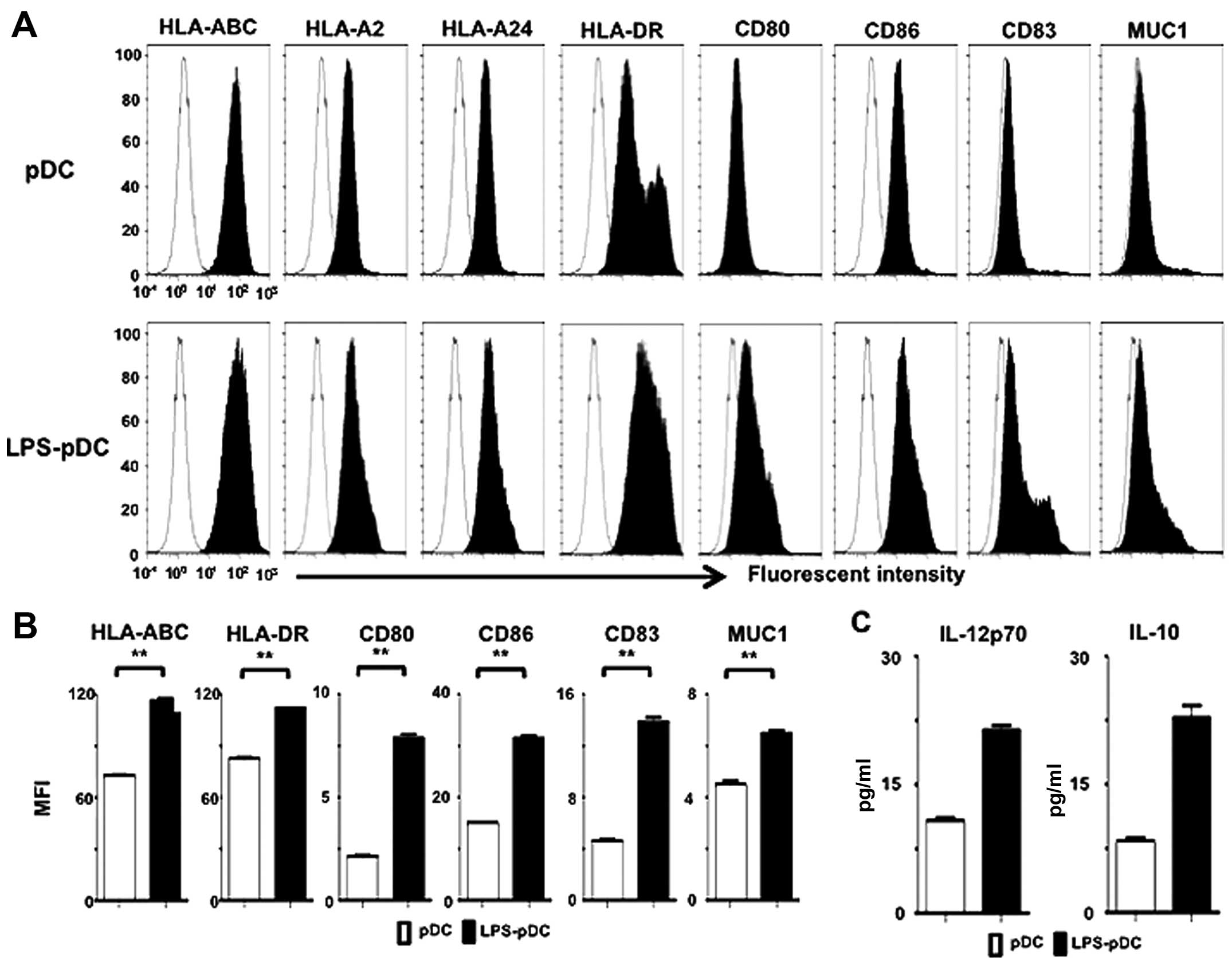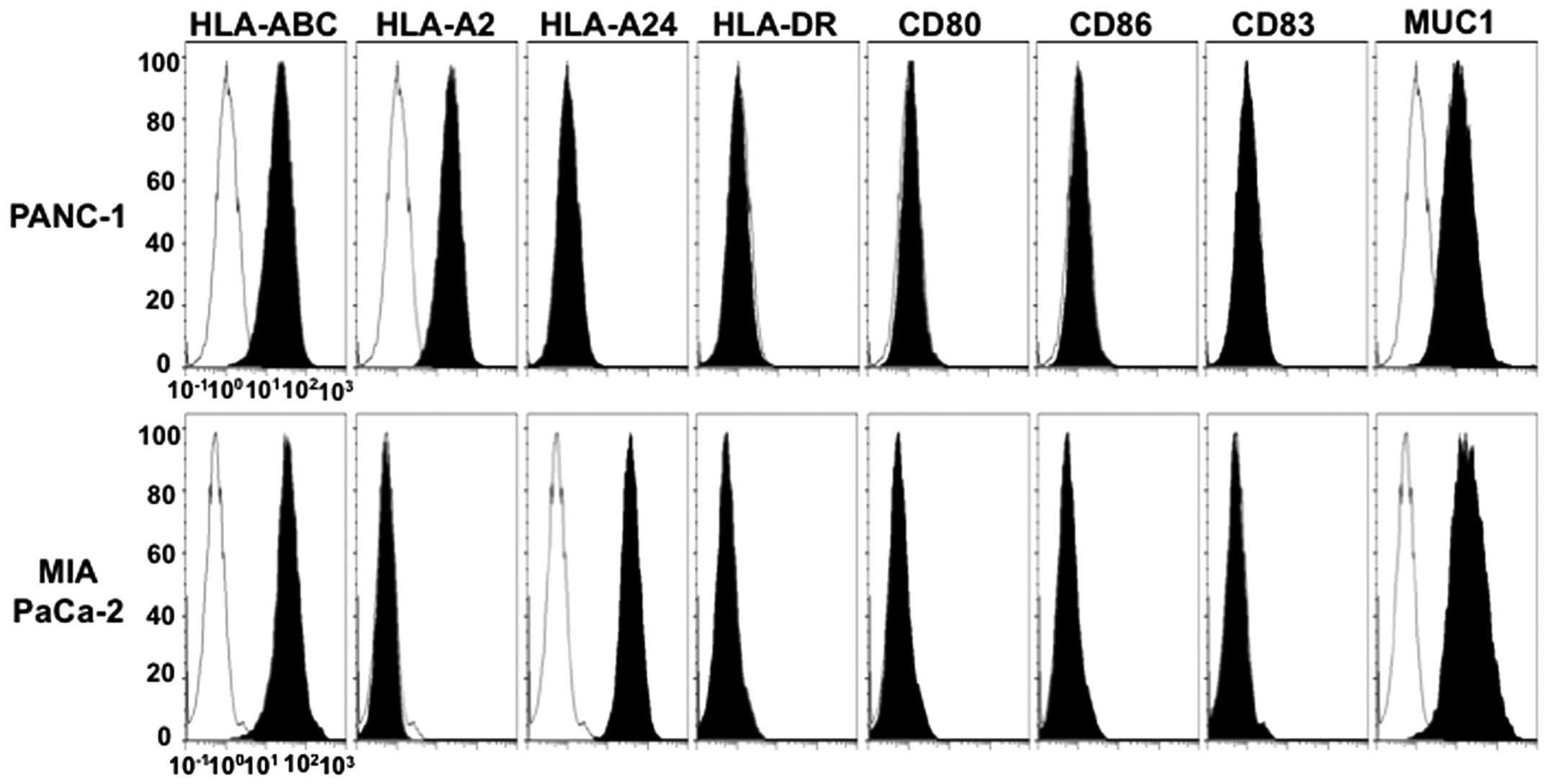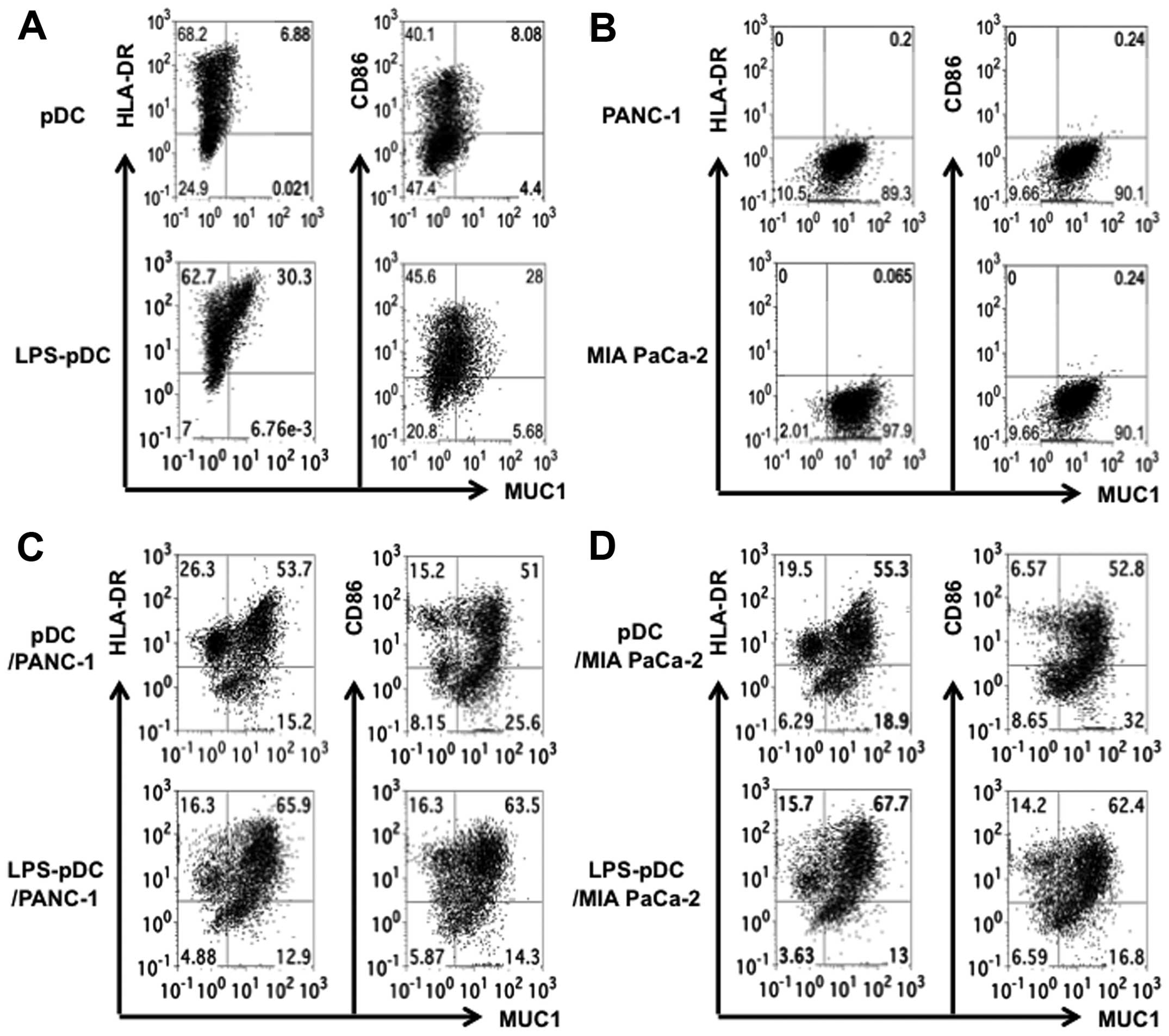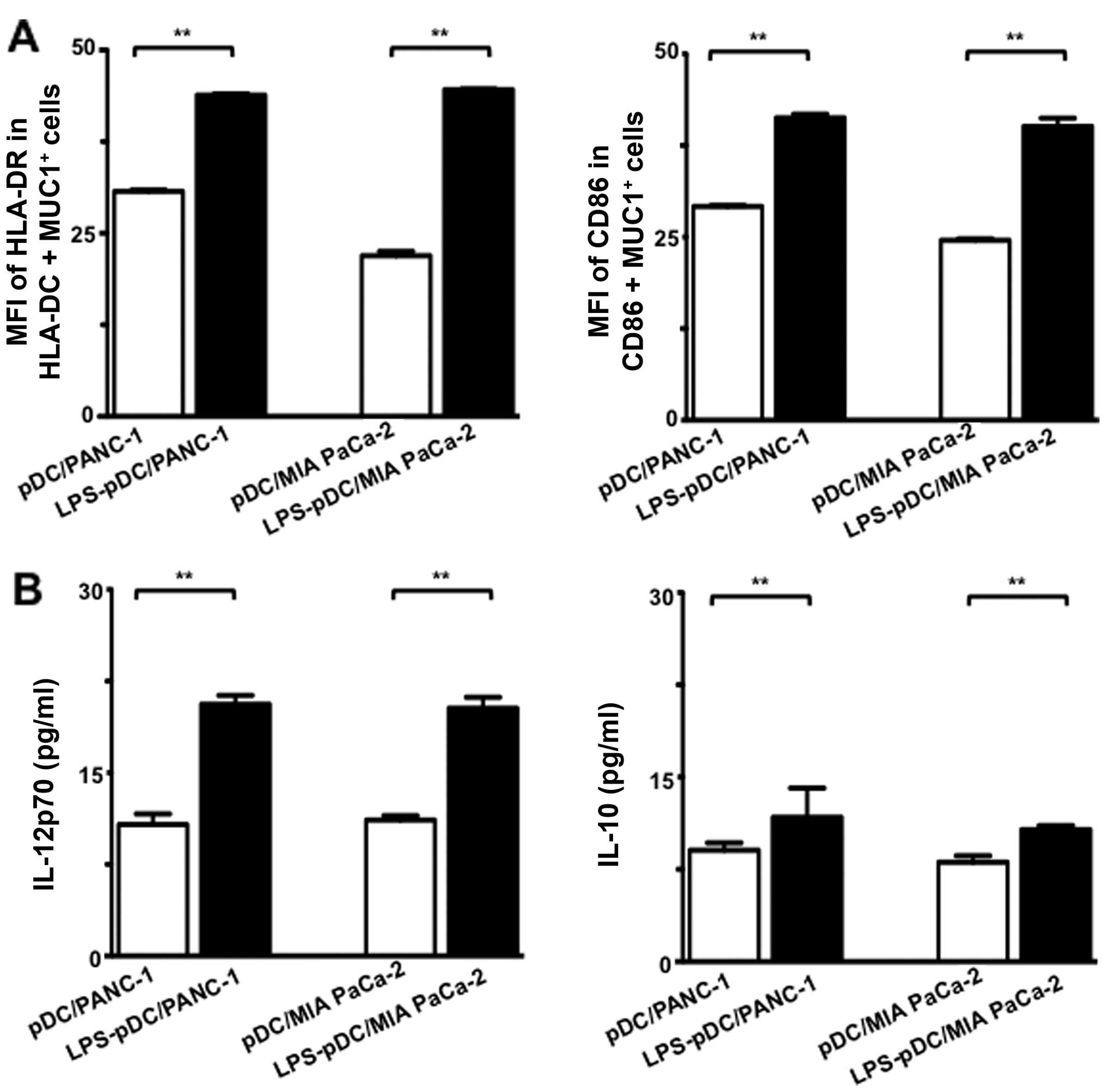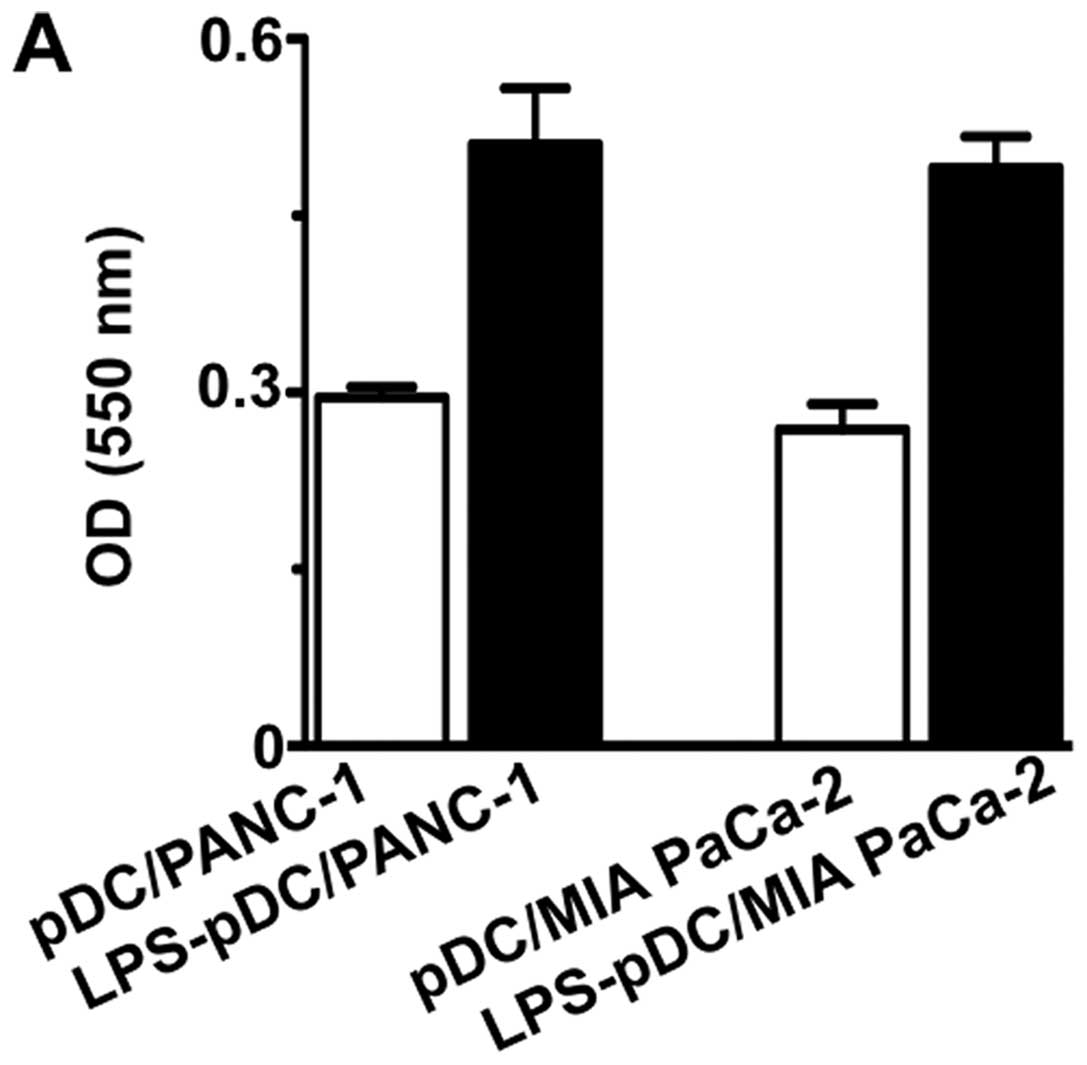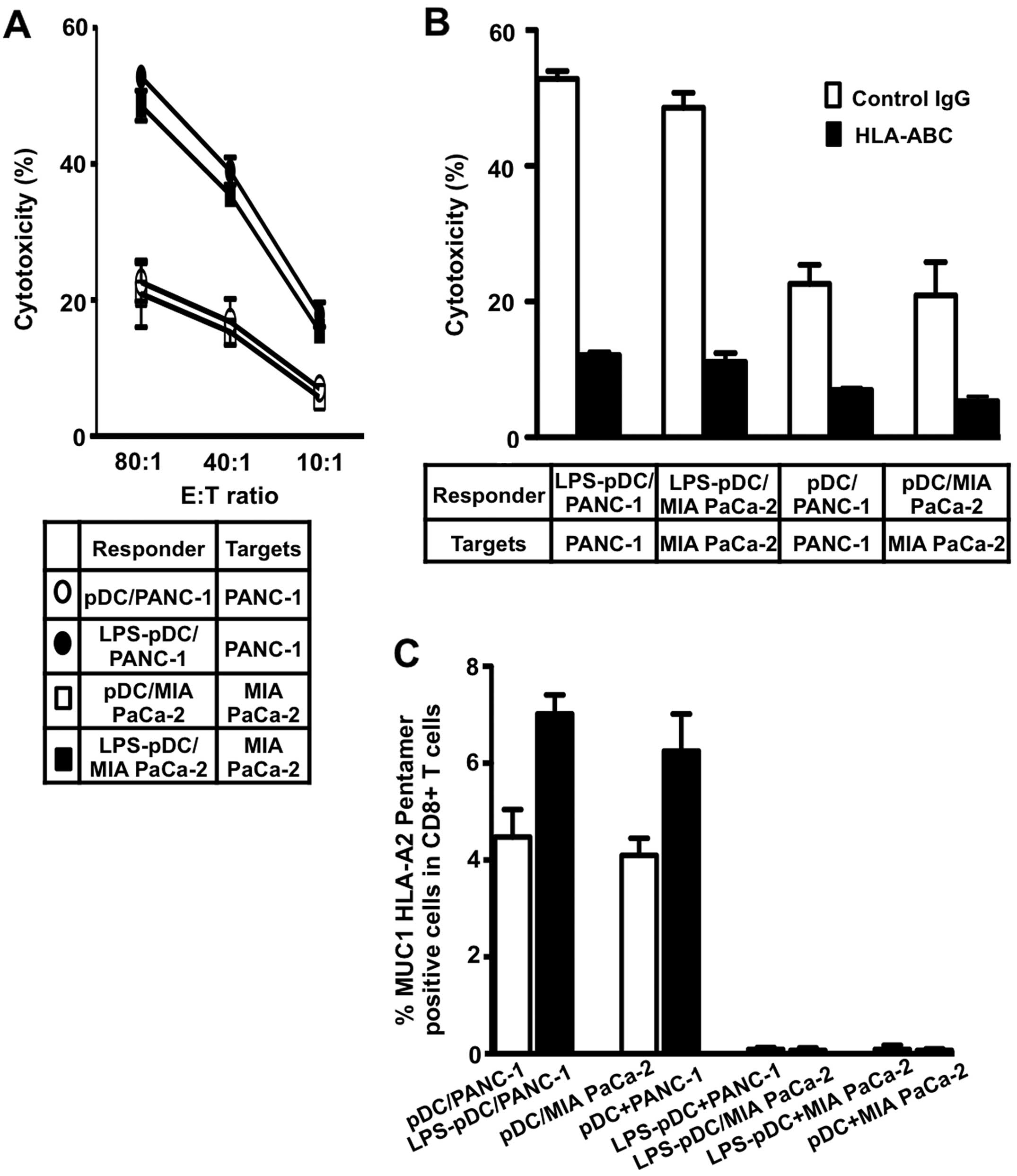Induction of antigen-specific cytotoxic T lymphocytes by fusion cells generated from allogeneic plasmacytoid dendritic and tumor cells
Corrigendum in: /10.3892/ijo.2015.2954
- Authors:
- Published online on: May 9, 2014 https://doi.org/10.3892/ijo.2014.2433
- Pages: 470-478
Abstract
Introduction
Dendritic cells (DCs) are specialized antigen-presenting cells (APCs) that play a critical role in the induction of primary immune responses (1). Therefore, several strategies have been developed to deliver tumor-associated antigens (TAAs) to autologous monocyte-derived dendritic cells (MoDCs) for the induction of efficient antigen-specific cytotoxic T lymphocytes (CTLs). One of the strategies is the administration of fusion cells generated from MoDCs and whole tumor cells (2). In MoDC/tumor fusions, a broad array of TAAs, including known and unidentified molecules, are delivered to MoDCs, processed, and presented to CD4+ and CD8+ T cells in complex with MHC class I and II molecules and in the context of co-stimulatory signals (3,4). Moreover, MoDCs and tumor cells can be independently subjected to manipulations for the acquisition of desired characteristics that persist after fusion (4).
A major limitation to the use of MoDC/tumor fusions is the availability of adequate amounts of autologous tumor cells, which stems from the limited availability of viable tumor samples and/or technical difficulties in cancer cell culture. Moreover, MoDCs from advanced cancer patients may be defective in their antigen-processing and presentation machinery due to the presence of tumor-derived immune suppressive molecules or as a result of chemotherapy (5). To circumvent all of these issues, allogeneic DC and tumor cell lines can be used instead of autologous cells. Cell lines that are well characterized can be massively propagated in vitro under good manufacturing practice (GMP) standards. Thus, unlimited amounts of DC/tumor fusion cells can be readily available.
As APCs, plasmacytoid DCs (pDCs) have not been used extensively in cancer vaccines thus far because they are more difficult to isolate from human blood monocytes and to obtain in sufficient quantities; however, they are more efficient than MoDCs in triggering antitumor immune responses (6–8). Moreover, pDCs differ from MoDCs in many aspects, such as TLR expression, and are capable of antigen capture, processing and presentation (9,10). A human leukemia pDC line (PMDC05) was recently generated (11,12) and tested for its capacity to induce effective antigen-specific CTLs upon peptide pulsing (13,14). However, little is known about whether antigen-specific CTLs can be induced by pDC/tumor fusion cells.
Here, we show that fusions generated with a pDC line and a pancreatic cancer cell line expressing MUC1 antigens induce MUC1-specific CTLs in vitro. Moreover, significantly augmented MUC1-specific CTLs are induced by lipopolysaccharide (LPS)-stimulated pDC/tumor fusion cells in vitro compared with unstimulated pDC/tumor fusion cells. By selecting cancer cell lines that express the same TAAs as autologous tumor cells, pDC/tumor fusions can be made from cells that are available in the laboratory, without the use of any patient or donor materials and avoiding the constraints of autologous cells.
Materials and methods
Cells and conditioned medium
PANC-1 (MUC1+, HLA-A2+, HLA-A24−), MIA PaCa-2 (MUC1+, HLA-A2−, HLA-A24+) and K562 (MUC1+, HLA-A2−, HLA-A24−) cells were purchased from the American Type Culture Collection (ATCC, Manassas, VA, USA) and maintained in Dulbecco’s modified Eagle’s medium (DMEM) supplemented with 100 U/ml penicillin, 100 mg/ml streptomycin and 10% fetal calf serum (FCS) (15). The leukemic pDC line PMDC05 was kindly gifted from Dr Takahashi (Laboratory of Hematology and Oncology, Graduate School of Health Sciences, Niigata University, Niigata, Japan). The PMDC05 cells were cultured at a cell concentration of 1×106/ml in Iscove’s modified Dulbecco’s medium (IMDM) supplemented with 100 U/ml penicillin, 100 mg/ml streptomycin and 10% FCS.
Fusion of pDCs and tumor cells
We developed four types of pDC/tumor fusions by alternating fusion cell partners and treating LPS as follows: PMDC05 fused with PANC-1 (pDC/PANC-1), PMDC05 fused with MIA PaCa-2 (pDC/MIA PaCa-2), PMDC05 fused with PANC-1 in the presence of LPS (LPS-pDC/PANC-1) and PMDC05 fused with MIA PaCa-2 in the presence of LPS (LPS-pDC/MIA PaCa-2). Briefly, pancreatic cancer cells (PANC-1 or MIA PaCa-2) were mixed with pDCs (PMDC05) at a ratio of 1:1, and fusion cells were generated using 50% polyethylene glycol (PEG) (Sigma-Aldrich, St. Louis, MO) (3). The fusion cells were maintained in DMEM with or without 0.1 g/ml LPS (Sigma-Aldrich). After 3 days of culture, the fusion cell preparations were integrated to a single entity and purified by gentle pipetting (16).
Phenotype analysis
Cells were incubated with FITC-conjugated monoclonal antibodies (mAbs) against MUC1 (CD227 clone HMPV; BD Pharmingen, San Jose, CA), MHC class I (W6/32), MHC class II (HLA-DR), B7-1 (CD80), B7-2 (CD86), CD83 (BD Pharmingen), HLA-A2 and HLA-A24 (One Lambda, Canoga Park, CA) or matched isotype control IgG. The pDC populations were gated based on their forward- vs. side-scatter profile and then analyzed for their expression of HLA-ABC, HLA-DR, CD80, CD86, CD83 and MUC1. For analysis of dual expression in the fusion cell preparations, the cells were incubated with a FITC-conjugated mAb against MUC1 and PE-conjugated mAbs against HLA-DR and CD86. After the cell aggregates were gated out (16), the fused cells were identified as MUC1 + HLA-DR+ or MUC1 + CD86+ using a FACScan flow cytometer (Becton-Dickinson, Mountain View, CA) and FlowJo analysis software (TreeStar, OR, USA).
T cell stimulation
The study protocol was reviewed and approved by the ethics committee of the Institutional Review Board of the Jikei University School of Medicine as well as the clinical study committee of the Jikei University Kashiwa Hospital [No. 14–60 (3209)]. Peripheral blood mononuclear cells (PBMCs) from whole blood (HLA-A2+ and HLA-A24+) were obtained with written informed consent from each individual. Briefly, PBMCs were prepared by Ficoll density gradient centrifugation and incubated in tissue culture flasks at 37°C for 30 min in Roswell Park Memorial Institute (RPMI) 1640 medium supplemented with 1% heat-inactivated autologous serum. After incubation for 60 min at 37°C to allow for adherence, the non-adherent cells were cultured with pDC/tumor fusion cells, pDCs or tumor cells. The number of pDC/tumor fusion cells was determined based on the number of cells that coexpressed HLA-DR and MUC1 in the fusion cell preparations. Equal numbers of each type of pDC/tumor fusion cell (HLA-A2+ and HLA-A24+) were cocultured with the non-adherent PBMCs (HLA-A2+ and HLA-A24+) at a ratio of 1:10 in the absence of recombinant human (rh)IL-2 for 3 days and then purified through nylon wool to remove the APCs. A low dose of rhIL-2 (10 U/ml; Shionogi, Osaka, Japan) was added on Day 4 and maintained until Day 8. pDCs, tumor cells and pDCs mixed with tumor cells were used as controls.
Enzyme-linked immunosorbent assay (ELISA)
pDC/tumor fusion cells (1×105 cells/ml/well) or pDCs (1×105 cells/ml/well) were cultured for 48 h, and their supernatants were tested for IL-12p70 and IL-10 expression (R&D Systems, Minneapolis, MN). The minimum detectable concentration of human IL-12p70 is typically <0.5 pg/ml.
Proliferation assay
Stimulated T cells were harvested by nylon wool separation and cultured in 96-well U-bottomed culture plates at 7×104 cells/well for 1 day. Dye solution was added to each well and incubated for 4 h according to the protocol of the Cell Titer 96 Non-radioactive Cell Proliferation Assay kit (Promega, Madison, WI). For measurement of proliferating T cells, we used a Microplate Imaging System (Bio-Rad, Hercules, CA) at an OD of 550 nm.
IFN-γ-producing CD4+ and CD8+ T cells
Stimulated T cells were harvested by nylon wool separation, and their human IFN-γ production was analyzed using an IFN-γ secretion assay kit (Miltenyi Biotec, Auburn, CA) according to the manufacturer’s instructions. Briefly, the T cells were incubated with IFN-γ catching reagent for 5 min at 4°C and then cultured for 45 min. Next, the cells were stained with a PE-conjugated anti-IFN-γ mAb and FITC-conjugated mAbs against CD4 and CD8 (BD Pharmingen), washed, fixed with 2% paraformalde-hyde and analyzed by flow cytometry using FlowJo analysis software. The T cell populations were gated based on their forward- vs. side-scatter profile. The CD4+ and CD8+ T cell populations were each gated, and then the percentages of IFN-γ-positive CD4+ and CD8+ T cells among the whole CD4+ and CD8+ T cell populations were calculated.
MUC1 pentamer staining
Stimulated T cells were harvested by nylon wool separation and then incubated with a PE-conjugated MUC1 pentamer (HLA-A2, STAPPVHNV) (Proimmune, Oxford, UK) for 1 h at 4°C. After washing, the T cells were stained with a FITC-conjugated mAb against CD8 (BD Pharmingen), washed, fixed with 2% paraformalde-hyde and analyzed by flow cytometry using FlowJo analysis software. Complexes of PE-irrelevant pentamers were used as controls. The T cell populations were gated based on their forward- vs. side-scatter profile. The CD8+ T cell populations were gated, and then the percentage of MUC1 pentamer-positive CD8+ T cells among the whole CD8+ T cell population was calculated.
Cytotoxicity assays
The cytotoxicity assays were performed by flow cytometric analysis using Active Caspase-3 Apoptosis kit I (BD Pharmingen), which measures CTL-induced caspase-3 activation in target cells by detecting the specific cleavage of fluorogenic caspase-3 (17). Briefly, the target cells were labeled with PKH-26 (Sigma-Aldrich), washed, cultured with stimulated T cells for 2 h at 37°C in 96-well V-bottomed plates at the indicated effector cell:T cell (E:T) ratios. The cells were then fixed with Cytofix/Cytoperm Solution (BD Pharmingen), washed with Perm/Wash Buffer (BD Pharmingen) and incubated with a FITC-conjugated mAb against human active caspase-3 (BD Pharmingen) for 30 min at room temperature, followed by two washes with Perm/Wash buffer. In certain experiments, the tumor target cells were preincubated with anti-HLA-ABC mAb (W6/32; 1:100 dilution) or control IgG for 30 min at 37°C before adding the effector cells. The percentage of cytotoxicity (mean ± SD of three replicates) was determined using the following equation: percentage of caspase-3 staining = (caspase-3+PKH-26+cells)/(caspase-3+PKH-26+cells + caspase-3-PKH-26+cells) ×100.
Statistical analysis
The results are expressed as means ± SD, as indicated in the legends. One-way analysis of variance was used to determine significance. When the P-values ≤0.05, the differences were considered to be statistically significant.
Results
Characterization of the cell lines used for fusion
The pDC line PMDC05 displayed a characteristic phenotype, with easily detectable levels of HLA-ABC, HLA-DR, CD80 and CD86 but low levels of CD83 and very low levels of MUC1 (CD227) (Fig. 1A). Stimulation of this pDC line with LPS (LPS-pDC) resulted in the upregulated expression of HLA-ABC, HLA-DR, CD80, CD86, CD83 and MUC1 (CD227) compared with unstimulated pDCs (Fig. 1A and B). Moreover, the LPS-pDCs exhibited increased levels of IL-12p70 and IL-10 compared with unstimulated pDCs (Fig. 1C). These results suggest that LPS activates pDCs. The pancreatic cancer cell lines used in this study, PANC-1 and MIA PaCa-2, expressed high levels of HLA-ABC and MUC1 but did not express HLA-DR, CD80, CD86 or CD83 (Fig. 2). Moreover, the PANC-1 cells expressed HLA-A2 but not HLA-A24, and conversely, the MIA PaCa-2 cells expressed HLA-A24 but not HLA-A2 (Fig. 2).
Characterization of the pDC/tumor fusion cells
To assess the capacity of the pDC/tumor fusion cells to induce antigen-specific CTL responses in vitro, we developed four types of fusion cell preparations by alternating fusion partners and treating with LPS. PANC-1 and MIA PaCa-2 cells were each successfully fused with pDCs with or without LPS stimulation (Fig. 3). The fusion efficiency was determined using the percentage of MUC1 and HLA-DR or CD86 double-stained cells (Fig. 3). Analysis of the fusion cells created from the pancreatic cancer cells and the pDCs demonstrated that about 50% of the popul ation expressed both MUC1 and HLA-DR or CD86 (Fig. 3C and D). Interestingly, the fusions generated in the presence of LPS exhibited higher double-positive cells that expressed MUC1 and HLA-DR or CD86 than those generated with the unstimulated pDCs (Fig. 3C and D).
Next, to attain a detailed phenotypic characterization of the DC/tumor fusion cells, the mean fluorescence intensity (MFI) of HLA-DR and CD86 expression was determined by FACS analysis, where the fused cells were identified as MUC1 + HLA-DR+ or MUC1 + CD86+. Although the pDC/PANC-1 and pDC/MIA PaCa-2 cells displayed high MFI values for HLA-DR and CD86, the LPS-DC/PANC-1 and LPS-DC/MIA PaCa-2 cells exhibited higher MFI values on a per-fusion-cell basis (Fig. 4A). Therefore, fusions generated in the presence of LPS may have a more active phenotype compared to those generated with unstimulated pDCs.
Furthermore, we assessed the production of IL-12p70 and IL-10 in the supernatants from the fusion cell preparations. About 2-fold higher levels of IL-12p70 production were observed for the LPS-pDC/PANC-1 and LPS-pDC/MIA PaCa-2 cells compared with the pDC/PANC-1 and pDC/MIA PaCa-2 cells (Fig. 4B). Moreover, IL-10 production was also increased in the LPS-pDC/PANC-1 and LPS-pDC/MIA PaCa-2 cells but to a lesser extent than that observed for IL-12p70 (Fig. 4B). Collectively, these results suggest that the upregulated production of IL-12p70 and the active phenotype of the fusion cells generated in the presence of LPS increase their immunogenicity.
Stimulation of T cells by the pDC/tumor fusions
Although all four types of fusions affected T cell proliferation, the LPS-pDC/tumor fusion cells showed the most significant stimulation of T cell proliferation (Fig. 5A). In addition, an unfused mixture of tumor cells and pDCs or LPS-DCs had no effect on T cell proliferation (data not shown). Moreover, both the pDC/tumor and LPS-pDC/tumor fusions stimulated IFN-γ-producing CD4+ and CD8+ T cells (Fig. 5B). However, the LPS-pDC/tumor fusion cells more strongly induced the proliferation of both CD4+ and CD8+ T cells that were capable of producing high levels of IFN-γ compared to the pDC/tumor fusion cells (Fig. 5B). In contrast, very low levels or no IFN-γ-producing cells were detected in the CD4+ and CD8+ T cell populations stimulated by an unfused mixture of DCs and tumor cells (data not shown). These results suggest that pDC/tumor fusion cells stimulated with LPS have a more potent capacity to induce CTL responses compared to unstimulated pDC/tumor fusion cells.
MUC1-specific CTL responses induced by the pDC/tumor fusions
The CTLs induced by all four types of fusions lysed the tumor target cells used for fusion (Fig. 6A and B) but not K562 cells (data not shown). Moreover, the lytic activity induced by the LPS-stimulated pDC/tumor fusions was significantly higher than that induced by the unstimulated pDC/tumor fusions (Fig. 6A and B), suggesting that LPS increases the immunogenicity of the pDC/tumor fusion cells to induce efficient CTL responses. In addition, preincubation of the target cells with an anti-HL-ABC mAb inhibited their lysis, indicating restriction by MHC class I molecules (Fig. 6B). Interestingly, an increased percentage of HLA-A2-restricted, MUC1-specific CD8+ T cells in the whole CD8+ T cell population was observed for the LPS-pDC/tumor fusions (HLA-A2+) compared with the pDC/tumor fusions (HLA-A2+) (Fig. 6C). In addition, CTLs specific for MUC1 were not detected in a population of T cells stimulated by an unfused mixture of tumor cells and pDCs or LPS-pDCs (Fig. 6D). Together, these findings indicate that HLA-A2-restrictive, MUC1-specific CTLs are efficiently induced by LPS-pDC/tumor fusions in vitro.
Discussion
The data presented herein show that DC/tumor fusion cells generated with a pDC line (HLA-A2+) and a pancreatic cancer cell line expressing MUC1 antigens induce HLA-A2-restricted, MUC1-specific CTLs in vitro. Moreover, LPS-stimulated pDC/tumor fusion cells efficiently induce augmented CTL responses.
We attempted to prepare immunogenic DC/tumor fusion cells using a DC line and a pancreatic cancer cell line. We used the plasmacytoid DC line PMDC05, a leukemic blast line that was isolated from a patient with acute leukemia (11,12) and has been reported to have the capacity to induce effective antigen-specific CTLs (13,14). This pDC line has been pulsed with peptide to induce CTL responses; however, little is known about its utility in cancer vaccines if used to generate pDC/tumor fusion cells. Cell lines that are well characterized can be massively propagated in vitro adhering to GMP. Thus, unlimited amounts of DC/tumor fusion cells can be readily available to induce antigen-specific CTLs for adoptive immunotherapy. Therefore, one important aspect of our work is its potential clinical relevance.
The binding of the pathogen-associated microbial pattern molecule LPS to Toll-like receptor (TLR) 4 on human MoDCs signals danger, which induces a potent immune stimulatory phenotype that is characterized by the release of IL-12p70 (18,19). Our finding that a pDC line activated with LPS is more active compared to unstimulated pDCs suggests that this TLR4 agonist plays a role in the activation of pDC functions (11). Moreover, LPS stimulation resulted in increased production of both IL-12p70 and IL-10 by the pDCs. The surface phenotype and cytokine production response pattern of the pDCs in this study was similar to that of human MoDCs (20), which implies that this pDC line possesses characteristics of MoDCs (11). Moreover, stimulation of the pDC line with LPS resulted in considerably increased expression of MUC1 (CD227) on the cell surface. MUC1 (CD227) is considered to be an epithelial mucin that is expressed extensively in pancreatic and other cancer types; thus, MUC1 is a target for immunotherapy in a variety of cancers (21). This molecule is also expressed by a wide variety of hemopoietic cells, from early differentiating bone marrow mononuclear cells to mature cell types (22). It is also known that MUC1 (CD227) is expressed by activated DCs and T cells (23). Therefore, LPS-stimulated pDCs, which express increased levels of MUC1 (CD227), HLA-ABC, -DR, CD80, CD86, CD83 and IL-12p70, may be suitable for cancer vaccines. Therefore, we speculated that fusion cells generated with a pDC line and a tumor cell line in the presence of a TLR4 agonist would be immunogenic and induce more effective MUC1-specific CTLs than their unstimulated counterparts. We successfully fused a pDC line with two different tumor cell lines with or without LPS stimulation. The pDC/tumor fusion cells were identified as MUC1 + HLA-DR+ or MUC1 + CD86+. The characteristic phenotype of the LPS-stimulated pDCs was associated with an increased percentage of double-positive cells (MUC1 + HLA-DR+ or MUC1 + CD86+) in the pDC/tumor fusion cell preparations (data not shown). Moreover, the cells that were double positive for MUC1 and HLA-DR or CD86 in the LPS-stimulated pDC/tumor fusion cell preparations had high MFI values for HLA-DR and CD86 on a per-fusion-cell basis, indicating that the fusions were more immunogenic compared to their unstimulated counterparts. Our previous report demonstrated that efficient CTL induction is closely correlated to fusion efficiency for fusion cells generated with MoDCs (24). LPS might provide the costimulation required during the fusion process and might be involved in polarizing the T cell responses to a Th1-dominant state. Therefore, the efficient activation of the pDC/tumor fusion cells by LPS led us to speculate that the MUC1-specific CTLs induced by these activated fusion cells would be more effective than conventional unactivated fusion cells.
We previously reported that the tumor antigens delivered to MoDCs by fusion cells were processed and presented in the context of MHC class I and II molecules of MoDC origin of fusion cells (15,25). Therefore, the HLA typing of the MoDCs and allogeneic tumor cell lines does not need to match (26). HLA-A2-restricted, MUC1-specific CTLs were efficiently generated with the fusion cells generated from allogeneic pDC (HLA-A2+) and MIA PaCa-2 (HLA-A−), suggesting that the MUC1 antigens from the MIA PaCa-2 cells were also processed and presented by HLA-A2 on the pDC part of pDC/tumor fusion cells. Although the LPS-pDC/tumor and pDC/tumor fusions stimulated IFN-γ-producing CD4+ and CD8+ T cells that lyse the tumor target cells used for fusion, the LPS-pDC/tumor fusions more strongly induced T cell activation, indicating that LPS stimulation is effective for pDC/tumor fusion cell vaccines. Moreover, the MUC1-specific CTLs were more effectively augmented by the LPS-pDC/tumor fusion cells compared to the pDC/tumor fusion cells. These results may be associated with the active function of LPS-DCs as PACs, as demonstrated by their mature phenotype, IL-12p70 production and increased MUC1 expression. In patients with melanoma or renal cell carcinoma, vaccines using fusions of allogeneic MoDCs and autologous tumor cells have been shown to induce efficient antitumor immune responses and clinical outcomes (27,28). Moreover, allogeneic tumor cell lines have been used in fusion cell vaccines in both preclinical (25,29,30) and clinical studies (31) and a MoDC/tumor fusion cell vaccine with fully allogeneic components has been demonstrated to induce clinical responses (31). Therefore, DC/tumor fusions generated with fully syngeneic, semi-allogeneic or fully allogeneic components are effective in inducing antigen-specific, long-lasting antitumor immunity (32).
In conclusion, our results indicate that fusion cell vaccines generated with a plasmacytoid DC line and tumor cell line can induce antigen-specific CTL responses in vitro. Our findings introduce the possibility of using defined allogeneic plasmacytoid DC and tumor lines to simplify CTL manufacturing for adoptive immunotherapy.
Acknowledgements
This study was supported by Grants-in-Aid for Scientific Research (C) from the Ministry of Education, Cultures, Sports, Science and Technology of Japan, the Foundation for Promotion of Cancer Research, the Mitsui Life Social Welfare Foundation, and a Grant-in-Aid from the Japan Medical Association. The funders had no role in the study design, data collection or analysis, decision to publish or manuscript preparation.
References
|
Steinman RM: The dendritic cell system and its role in immunogenicity. Annu Rev Immunol. 9:271–296. 1991. View Article : Google Scholar : PubMed/NCBI | |
|
Gong J, Chen D, Kashiwaba M and Kufe D: Induction of antitumor activity by immunization with fusions of dendritic and carcinoma cells. Nat Med. 3:558–561. 1997. View Article : Google Scholar : PubMed/NCBI | |
|
Gong J, Koido S and Calderwood SK: Cell fusion: from hybridoma to dendritic cell-based vaccine. Expert Rev Vaccines. 7:1055–1068. 2008. View Article : Google Scholar : PubMed/NCBI | |
|
Koido S, Homma S, Okamoto M, et al: Fusions between dendritic cells and whole tumor cells as anticancer vaccines. Oncoimmunology. 2:e244372013. View Article : Google Scholar : PubMed/NCBI | |
|
Yanagimoto H, Takai S, Satoi S, et al: Impaired function of circulating dendritic cells in patients with pancreatic cancer. Clin Immunol. 114:52–60. 2005. View Article : Google Scholar : PubMed/NCBI | |
|
Colonna M, Trinchieri G and Liu YJ: Plasmacytoid dendritic cells in immunity. Nat Immunol. 5:1219–1226. 2004. View Article : Google Scholar | |
|
Liu YJ: IPC: professional type 1 interferon-producing cells and plasmacytoid dendritic cell precursors. Annu Rev Immunol. 23:275–306. 2005. View Article : Google Scholar : PubMed/NCBI | |
|
Kim R, Emi M, Tanabe K and Arihiro K: Potential functional role of plasmacytoid dendritic cells in cancer immunity. Immunology. 121:149–157. 2007. View Article : Google Scholar : PubMed/NCBI | |
|
Segura E, Kapp E, Gupta N, et al: Differential expression of pathogen-recognition molecules between dendritic cell subsets revealed by plasma membrane proteomic analysis. Mol Immunol. 47:1765–1773. 2010. View Article : Google Scholar | |
|
Mouries J, Moron G, Schlecht G, Escriou N, Dadaglio G and Leclerc C: Plasmacytoid dendritic cells efficiently cross-prime naive T cells in vivo after TLR activation. Blood. 112:3713–3722. 2008. View Article : Google Scholar : PubMed/NCBI | |
|
Narita M, Watanabe N, Yamahira A, et al: A leukemic plasmacytoid dendritic cell line, PMDC05, with the ability to secrete IFN-alpha by stimulation via Toll-like receptors and present antigens to naive T cells. Leuk Res. 33:1224–1232. 2009. View Article : Google Scholar | |
|
Watanabe N, Narita M, Yamahira A, et al: Transformation of dendritic cells from plasmacytoid to myeloid in a leukemic plasmacytoid dendritic cell line (PMDC05). Leuk Res. 34:1517–1524. 2010. View Article : Google Scholar : PubMed/NCBI | |
|
Yamahira A, Narita M, Nakamura T, et al: Generation of antigen-specific cytotoxic T lymphocytes using a leukemic plasmacytoid dendritic cell line as antigen presenting cells. Leuk Res. 35:793–799. 2011. View Article : Google Scholar | |
|
Yamahira A, Narita M, Ishii K, et al: Enhancement of antigen presenting ability in the leukemic plasmacytoid dendritic cell line (PMDC05) by lentiviral vector-mediated transduction of CD80 gene. Leuk Res. 36:1541–1546. 2012. View Article : Google Scholar : PubMed/NCBI | |
|
Koido S, Hara E, Homma S, et al: Dendritic/pancreatic carcinoma fusions for clinical use: comparative functional analysis of healthy-versus patient-derived fusions. Clin Immunol. 135:384–400. 2010. View Article : Google Scholar : PubMed/NCBI | |
|
Koido S and Gong J: Characterization of structure and direct antigen presentation by dendritic/tumor-fused cells as cancer vaccines. Anticancer Res. 33:347–354. 2013.PubMed/NCBI | |
|
Liu L, Chahroudi A, Silvestri G, et al: Visualization and quantification of T cell-mediated cytotoxicity using cell-permeable fluorogenic caspase substrates. Nat Med. 8:185–189. 2002. View Article : Google Scholar : PubMed/NCBI | |
|
Lapteva N, Seethammagari MR, Hanks BA, et al: Enhanced activ ation of human dendritic cells by inducible CD40 and Toll-like receptor-4 ligation. Cancer Res. 67:10528–10537. 2007. View Article : Google Scholar : PubMed/NCBI | |
|
Luger R, Valookaran S, Knapp N, Vizzardelli C, Dohnal AM and Felzmann T: Toll-like receptor 4 engagement drives differentiation of human and murine dendritic cells from a pro- into an anti-inflammatory mode. PLoS One. 8:e548792013. View Article : Google Scholar : PubMed/NCBI | |
|
Koido S, Homma S, Okamoto M, et al: Combined TLR2/4-activated dendritic/tumor cell fusions induce augmented cytotoxic T lymphocytes. PLoS One. 8:e592802013. View Article : Google Scholar : PubMed/NCBI | |
|
Kimura T and Finn OJ: MUC1 immunotherapy is here to stay. Expert Opin Biol Ther. 13:35–49. 2013. View Article : Google Scholar : PubMed/NCBI | |
|
Brugger W, Buhring HJ, Grunebach F, et al: Expression of MUC-1 epitopes on normal bone marrow: implications for the detection of micrometastatic tumor cells. J Clin Oncol. 17:1535–1544. 1999.PubMed/NCBI | |
|
Wykes M, MacDonald KP, Tran M, et al: MUC1 epithelial mucin (CD227) is expressed by activated dendritic cells. J Leukoc Biol. 72:692–701. 2002.PubMed/NCBI | |
|
Koido S, Hara E, Homma S, et al: Streptococcal preparation OK-432 promotes fusion efficiency and enhances induction of antigen-specific CTL by fusions of dendritic cells and colorectal cancer cells. J Immunol. 178:613–622. 2007. View Article : Google Scholar | |
|
Koido S, Hara E, Homma S, et al: Dendritic cells fused with allogeneic colorectal cancer cell line present multiple colorectal cancer-specific antigens and induce antitumor immunity against autologous tumor cells. Clin Cancer Res. 11:7891–7900. 2005. View Article : Google Scholar | |
|
Koido S, Hara E, Homma S, Ohkusa T, Gong J and Tajiri H: Cancer immunotherapy by fusions of dendritic cells and tumor cells. Immunotherapy. 1:49–62. 2009. View Article : Google Scholar : PubMed/NCBI | |
|
Haenssle HA, Krause SW, Emmert S, et al: Hybrid cell vaccination in metastatic melanoma: clinical and immunologic results of a phase I/II study. J Immunother. 27:147–155. 2004. View Article : Google Scholar : PubMed/NCBI | |
|
Trefzer U, Herberth G, Wohlan K, et al: Tumour-dendritic hybrid cell vaccination for the treatment of patients with malignant melanoma: immunological effects and clinical results. Vaccine. 23:2367–2373. 2005. View Article : Google Scholar : PubMed/NCBI | |
|
Lundqvist A, Palmborg A, Bidla G, Whelan M, Pandha H and Pisa P: Allogeneic tumor-dendritic cell fusion vaccines for generation of broad prostate cancer T-cell responses. Med Oncol. 21:155–165. 2004. View Article : Google Scholar : PubMed/NCBI | |
|
Matsumoto S, Saito H, Tsujitani S and Ikeguchi M: Allogeneic gastric cancer cell-dendritic cell hybrids induce tumor antigen (carcinoembryonic antigen) specific CD8(+) T cells. Cancer Immunol Immunother. 55:131–139. 2006.PubMed/NCBI | |
|
Marten A, Renoth S, Heinicke T, et al: Allogeneic dendritic cells fused with tumor cells: preclinical results and outcome of a clinical phase I/II trial in patients with metastatic renal cell carcinoma. Hum Gene Ther. 14:483–494. 2003. View Article : Google Scholar | |
|
Siders WM, Garron C, Shields J and Kaplan JM: Induction of antitumor immunity by semi-allogeneic and fully allogeneic electrofusion products of tumor cells and dendritic cells. Clin Transl Sci. 2:75–79. 2009. View Article : Google Scholar : PubMed/NCBI |



